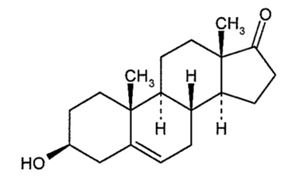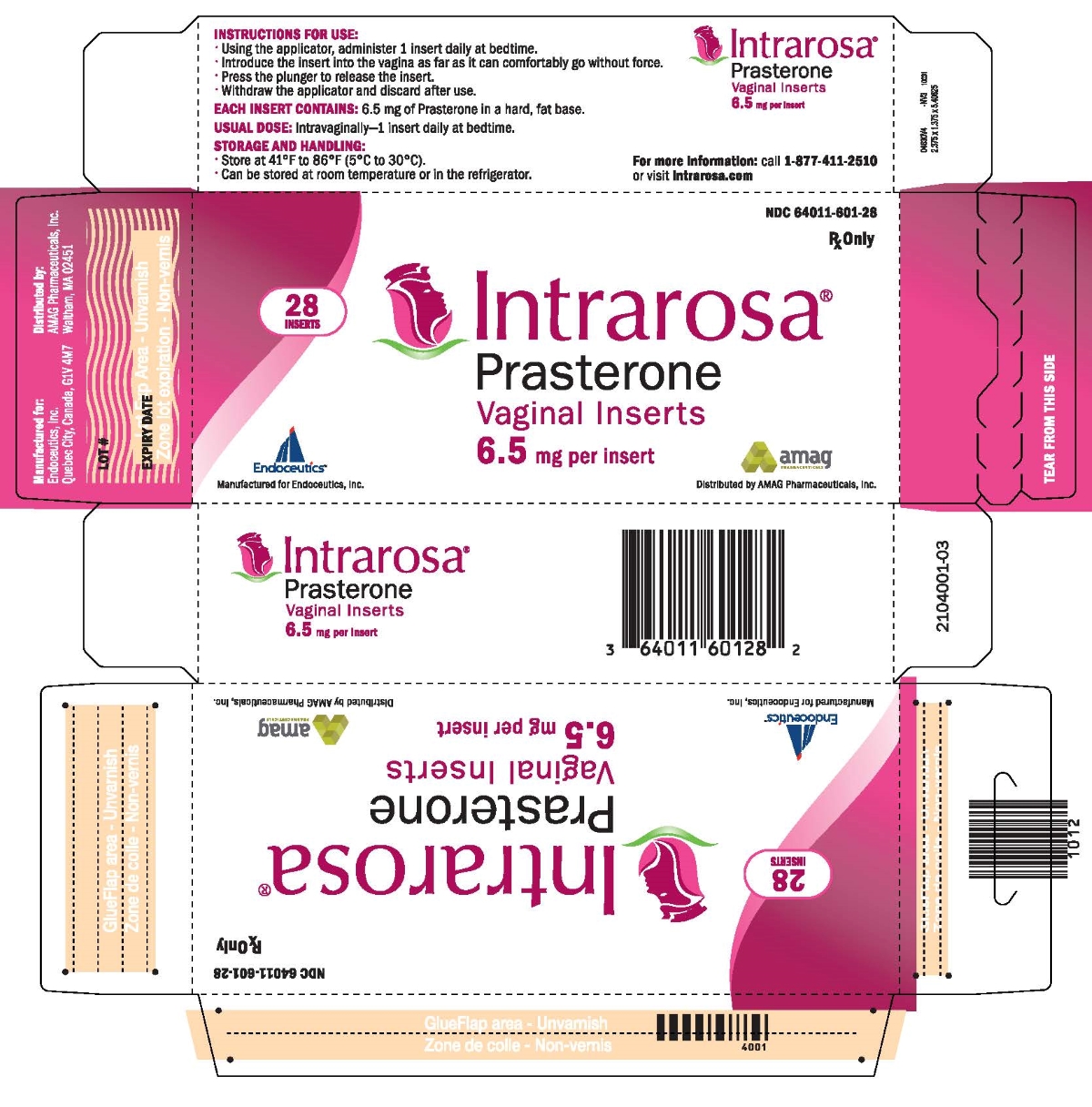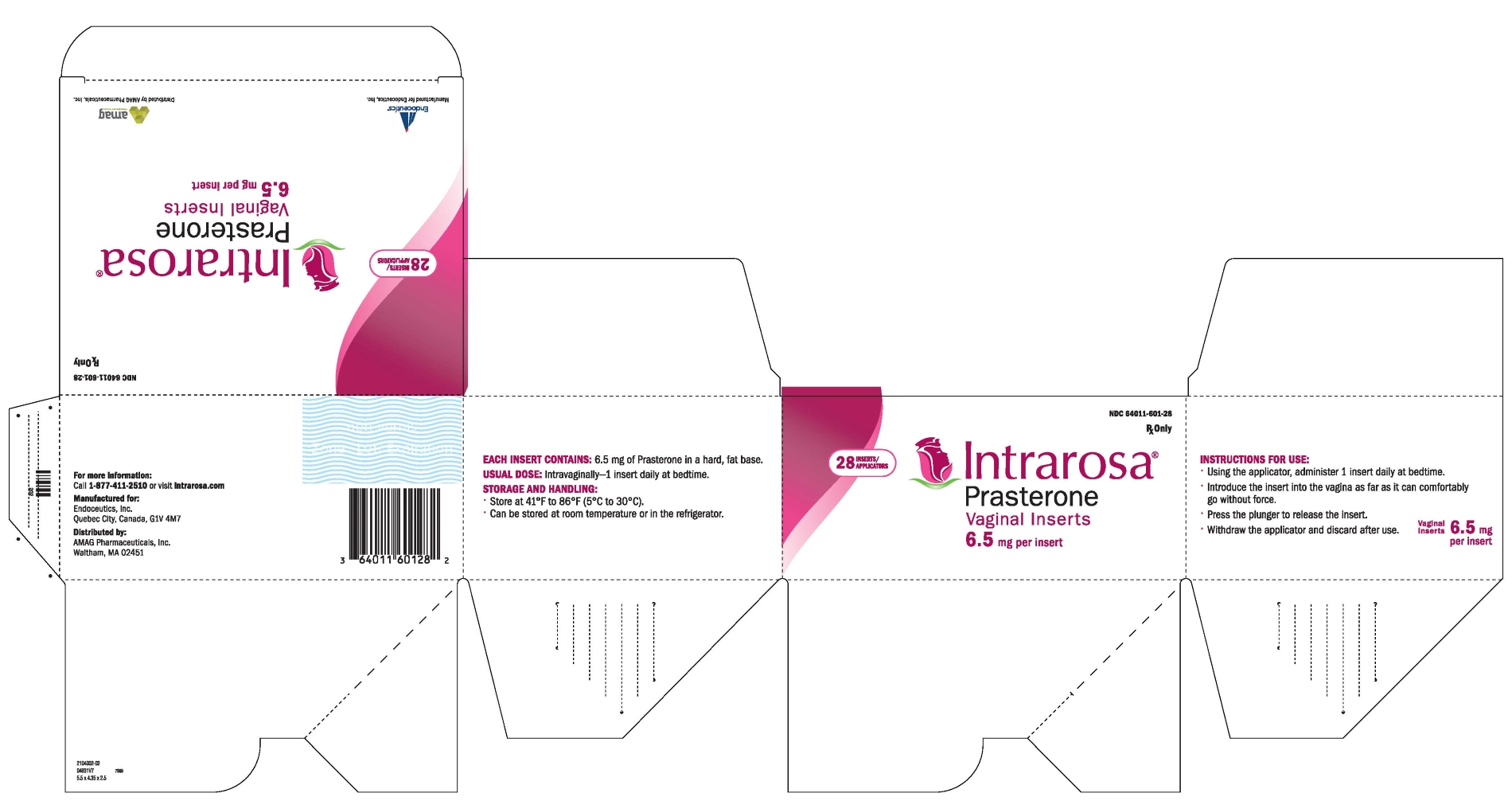Intrarosa
Generic name: prasterone (dehydroepiandrosterone, DHEA) vaginal
Medically reviewed by A Ras MD.
What is Intrarosa?
Intrarosa vaginal inserts are a prescription medicine used in women after menopause to treat moderate to severe pain during sexual intercourse caused by changes in and around the vagina that happen with menopause.
It is not known if Intrarosa vaginal inserts are safe and effective in children.
Description
INTRAROSA (prasterone) vaginal insert is a vaginally administered steroid. Prasterone is identified chemically as 3β-hydroxyandrost-5-en-17-one. It has the empirical formula C 19H 28O 2 with a molecular weight of 288.424 g/mol. Prasterone is a white to off-white crystalline powder insoluble in water and soluble in sodium lauryl sulfate (SLS). The structural formula is:

Each INTRAROSA (prasterone) vaginal insert contains 6.5 mg of prasterone in 1.3 ml of off-white hard fat (Witepsol).
Mechanism of Action
Prasterone is an inactive endogenous steroid and is converted into active androgens and/or estrogens. The mechanism of action of INTRAROSA in postmenopausal women with vulvar and vaginal atrophy is not fully established.
Who should not use Intrarosa?
Do not use Intrarosa vaginal inserts if you have vaginal bleeding that has not been checked by your healthcare provider.
What should I tell my healthcare provider before using Intrarosa?
Before using Intrarosa vaginal inserts, tell your healthcare provider about all of your medical conditions, including if you:
- have, have had, or think you may have had breast cancer. Prasterone, an ingredient in Intrarosa vaginal inserts, is changed in your body to estrogen. Estrogen medicines are not for use in women who have, have had, or think they may have had breast cancer.
- are pregnant or plan to become pregnant. Intrarosa is only for use in women who are past menopause. It is not known if Intrarosa vaginal inserts will harm your unborn baby.
- are breastfeeding or plan to breastfeed. Intrarosa vaginal inserts are only for use in women who are past menopause. It is not known if Intrarosa passes into your breast milk.
Tell your healthcare provider about all the medicines you take, including prescription and over-the-counter medicines, vitamins, and herbal supplements.
How should I use Intrarosa?
- See the instructions for use that come with Intrarose about the right way to use Intrarosa vaginal inserts.
- Use Intrarosa vaginal inserts exactly how your healthcare provider tells you to use it.
- Place 1 Intrarosa vaginal insert in your vagina one time each day at bedtime, using the applicator that comes with Intrarosa vaginal inserts.
What are the possible side effects of Intrarosa?
The most common side effects of Intrarosa vaginal inserts are irritation, vaginal discharge and changes on Pap smear.
These are not all of the possible side effects of Intrarosa vaginal inserts.
Call your doctor for medical advice about side effects. You may report side effects to FDA at 1-800-FDA-1088.
General information about the safe and effective use of Intrarosa
Medicines are sometimes prescribed for purposes other than those listed in a Patient Information leaflet. Do not use Intrarosa vaginal inserts for a condition for which it was not prescribed. Do not give Intrarosa vaginal inserts to other people, even if they have the same symptoms that you have. It may harm them. You can ask your pharmacist or healthcare provider for information about Intrarosa vaginal inserts that is written for health professionals.
How should I store Intrarosa?
- Store Intrarosa vaginal inserts between 41°F to 86°F (5°C to 30°C).
- Intrarosa vaginal inserts can be stored at room temperature or in the refrigerator.
Keep Intrarosa vaginal inserts and all medicines out of the reach of children.
What are the ingredients in Intrarosa?
Active ingredient: prasterone
Inactive ingredient: off-white hard fat (Witepsol)
Label
PRINCIPAL DISPLAY PANEL – NDC: 64011-601-28 – SMALL BOX (INSERTS)

PRINCIPAL DISPLAY PANEL – NDC: 64011-601-28 – OUTMOST LARGE BOX (INSERTS PLUS APPLICATORS)
